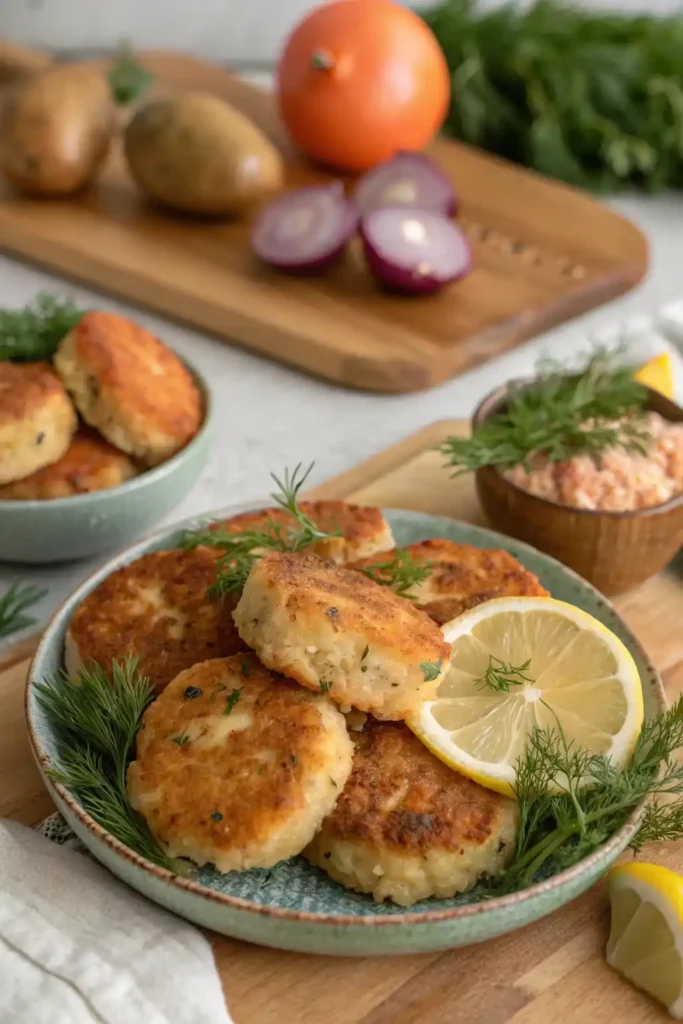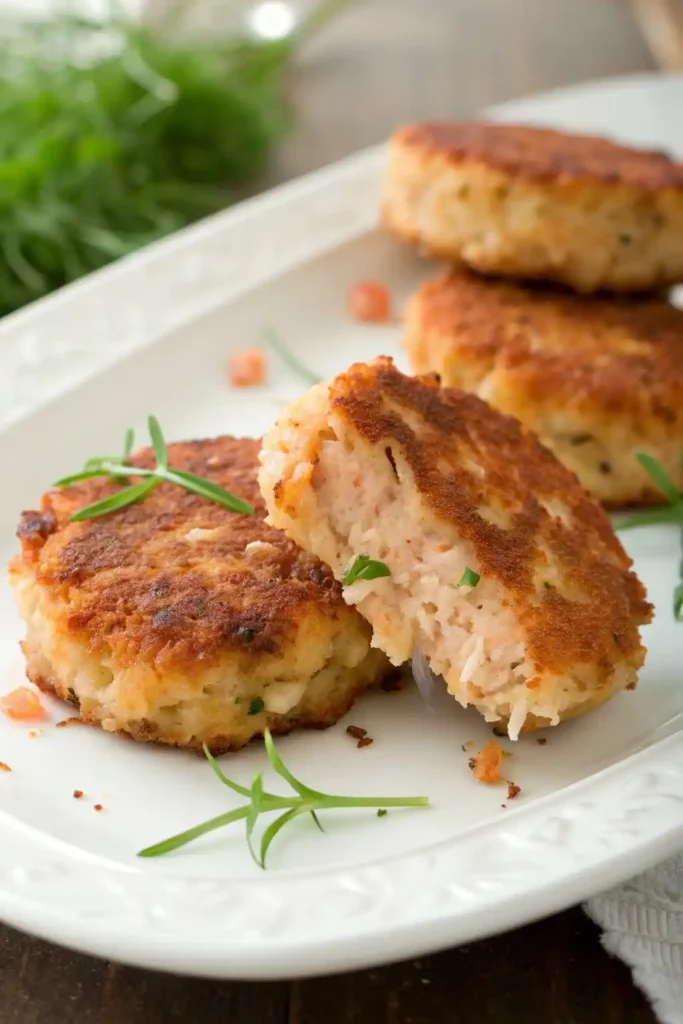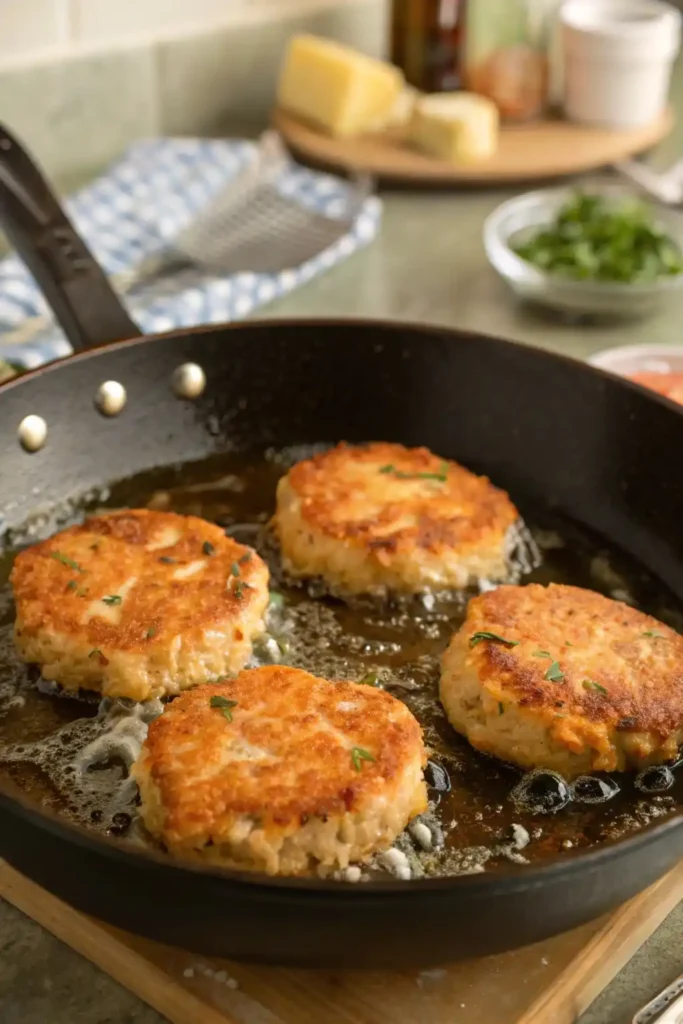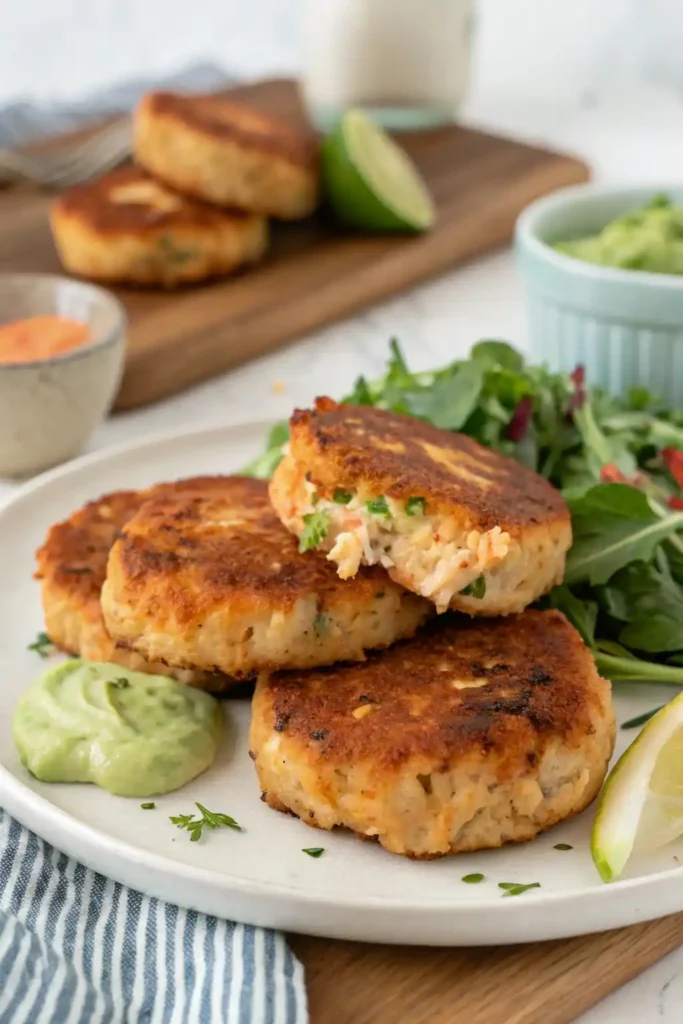This salmon cake recipe has earned a near-perfect rating of 4.98 from 740 votes and inspired over 1,250 glowing comments, proving its status as a foolproof family favorite.
The protein-packed patties deliver 28g of protein per serving, whether you choose convenient canned salmon or fresh filets. My family has enjoyed these salmon cakes more than 20 times, and they turn out perfect consistently. The best part? You don’t need to become skilled at cooking to make them successfully.
The recipe guides you through each step – from bone removal to achieving that golden-brown crust – helping you create restaurant-worthy salmon cakes. These versatile patties can be prepared ahead and frozen for up to 3 months, making them ideal for busy weeknight dinners.
Ready to create the most delicious salmon cakes you’ve ever tasted? Let’s get cooking!

Table of Contents
Choosing the Right Salmon for Your Cakes
The right type of salmon makes a significant difference in creating delicious salmon cakes. Your choice between fresh and canned salmon shapes everything from flavor and texture to preparation time and cost.
Fresh vs canned salmon: pros and cons
Fresh and canned salmon have distinct differences that affect your salmon patties. Fresh salmon gives you a meatier texture and beautiful rosy pink color. You might want to use it to impress guests or to use up leftover cooked salmon. It also lets you control exactly how much seasoning goes in.
Canned salmon brings its own set of benefits to the table. Blind taste tests show people actually preferred salmon cakes made with canned salmon because they taste saltier and more flavorful. The canned options are nowhere near as expensive and stay fresh in your pantry.
Red and pink are the two main varieties of canned salmon. Red salmon costs more and has a stronger flavor, while pink salmon gives you good taste at a better price. These varieties work great for salmon cakes. I use red salmon packed in water because it strikes the perfect balance between flavor and health benefits.
How to prep canned salmon properly
Start by draining most of the liquid from your canned salmon, leaving about 2 tablespoons behind. This extra liquid keeps your salmon cakes moist. The salmon should be flaked with a fork in a mixing bowl.
You might find skin and bones in some canned salmon. The bones become soft during canning and add calcium, so they’re safe to eat, but you can take them out if you want. The soft bones can be crushed and mixed right in.
High-quality “boneless and skinless” canned salmon (usually in 5-ounce cans) lets you skip the sorting step. This makes the process quick and almost as easy as working with fresh salmon.
Tips for removing bones and skin
Fresh salmon needs a sharp knife and steady hand to remove the skin. Put the salmon skin-side down on your cutting board and cut between the flesh and skin. The skin comes off easier if you hold it with paper towels. Keep your knife tilted slightly downward and parallel to the board. A firm pull on the skin while moving the knife in a sawing motion works best.
Pin bones can be found by running your fingers along the filet. These bones line up in a row just below the surface. Pull each bone out at an angle using needle-nose pliers or fish tweezers – regular tweezers don’t grip well enough.
The sort of thing I love about grocery stores is that fishmongers will remove skin and bones at no extra cost. This saves precious time in your kitchen.
Mixing the Perfect Salmon Cake Base

The perfect base mixture will turn flaky salmon into delicious cakes that stay together perfectly. My experience shows that knowing how ingredients work together makes a huge difference in getting restaurant-quality results.
Key ingredients for structure and flavor
Great salmon cakes start with the right binding agents. You’ll need 1-2 large eggs per pound of salmon to keep everything together. Breadcrumbs are vital for structure, and panko gives you better crunch than regular breadcrumbs.
Mayonnaise adds moisture and richness – about 3 tablespoons per recipe will give you the right consistency. A teaspoon of Worcestershire sauce adds deep umami flavor that makes the salmon taste even better.
Simple salmon cakes become gourmet dishes with these aromatic ingredients:
- Onions and bell peppers softened in butter for 7-9 minutes add sweetness and texture
- Fresh minced parsley (¼ cup) or dill brings brightness
- Dijon mustard (1-2 tablespoons) adds tangy complexity
- Old Bay seasoning creates that classic seafood taste
The texture of your mixture really matters. Fresh salmon should be cut into ¼-inch pieces instead of bigger chunks so everything binds properly.
How to fix a mixture that’s too wet or too dry
Getting the right consistency can be challenging. Add more panko breadcrumbs slowly if your salmon cake mixture seems too wet. An extra tablespoon of mayonnaise will help if the mixture falls apart.
Mix ingredients until they combine well but still have some texture – this “whipped consistency” works great. The patties will definitely hold together if you refrigerate them for at least 30 minutes before cooking.
A ⅓-cup measure or ice cream scoop helps make equal-sized cakes. Shape them gently into 1-inch thick patties. This method ensures they cook evenly throughout.
Cooking Salmon Cakes to Golden Perfection

Your choice of cooking method shapes the final texture and flavor of salmon cakes. The best ones have a golden-brown crust outside and stay moist and flavorful inside.
Pan-frying vs baking: which is better?
Salmon cakes get crispier when you pan-fry them. Hot oil creates that delicious golden-brown crust and locks in moisture. All the same, baking comes with its own benefits—we cooked with less mess, reduced fat, and you can make more cakes at once.
Medium to medium-high heat works great for pan-frying. Baking needs a 425°F preheated oven with salmon cakes laid out on parchment-lined baking sheets. Let them cook for 15 minutes, flip them over, and give them another 5 minutes.
How to prevent cakes from falling apart
Your patties need to chill in the fridge for at least 30 minutes before cooking—this is a vital step for keeping them together. It also helps to follow these tips:
- Don’t press down on the cakes while they cook or they’ll stick to the pan
- Pick a wide spatula that supports the whole cake when flipping
- Let a golden crust form before you flip—about 3½ to 4 minutes each side
The mixture’s consistency might be off if your salmon cakes keep breaking apart. Mix in another egg or a spoonful of mayonnaise if they’re too dry, or add more breadcrumbs if they’re too wet.
Oil temperature and timing tips
Start with 2 tablespoons of oil in your skillet over medium-high heat. The oil should shimmer but not smoke before adding the cakes. Turn down the heat if they brown too fast.
Cook each side for 3-4 minutes until they turn golden brown. Of course, you’ll spot the right time to flip when edges set and the bottom gets that golden color. Cook them in batches if needed—just add fresh oil between rounds.
Make your patties about ½-inch to ⅔-inch thick throughout to ensure they cook evenly.
Make-Ahead, Freezing, and Reheating Tips
Salmon cakes are a great make-ahead meal that saves time on busy weeknights. You can enjoy these tasty patties anytime with the right storage methods.
How to freeze raw vs cooked salmon cakes
Raw salmon cakes need simple preparation. Shape the patties and place them on a parchment-lined baking sheet without the outer breadcrumb coating. Let them freeze solid (about 1 hour), then move them to freezer bags or containers. Raw patties stay fresh in the freezer for up to 2 months.
Cooked salmon cakes make life easier. Let them cool completely before freezing. The best method is to freeze the patties separately on a baking sheet for about an hour, then move them to a freezer-safe container. Add parchment paper between layers so they don’t stick together. Your cooked salmon cakes will last up to 3 months in the freezer.
Best way to reheat without drying out
Your oven will give you the best results when reheating. Thaw frozen salmon cakes in the refrigerator overnight. Put them on a baking sheet and cover them loosely with foil to keep moisture in. Reheat at 350°F for 10-15 minutes until they’re warm throughout.
The food tastes substantially better when thawed before reheating rather than cooking straight from frozen. Tests show that salmon reheated from frozen turns grayish and gets as dry as canned fish. You should plan ahead for thawing.
Microwaving works if you’re short on time, though the texture changes a bit. A damp paper towel over the patties helps keep them moist.
Meal prep tips for busy weeks
Make extra batches of salmon cakes just for freezing. The effort stays almost the same but helps you on busy days.
Raw mixture stays good in the refrigerator for up to 24 hours before shaping into patties. Cooked patties last 3-5 days in airtight containers in the fridge.

You can make complete meal prep containers by combining cooled salmon cakes with sides like coleslaw or roasted vegetables in divided containers. These ready-made meals stay fresh in the refrigerator for up to 4 days.
Conclusion
You don’t need professional culinary skills to create perfect salmon cakes – just attention to detail and the right techniques. These protein-rich patties give you plenty of options. Fresh salmon filets or budget-friendly canned options work equally well.
The secret to great results lies in your salmon preparation, mixture consistency, and cooking temperature. Over the last several years, I’ve learned that refrigerating the patties before cooking makes them better. The right oil temperature transforms ordinary patties into restaurant-worthy creations.
These versatile cakes are perfect for meal prep. They stay fresh up to 3 months in the freezer with proper storage. Your busy weeknights become easier with these make-ahead options that taste just as delicious. Thawing frozen patties overnight ensures the best texture and flavor.
Want to discover more delicious recipes? Check out more recipes and meal ideas in this piece to create memorable dishes for your family.
FAQs
Q1. What’s the best type of salmon to use for salmon cakes? Both fresh and canned salmon work well. Fresh salmon provides a meatier texture, while canned salmon is more convenient and often preferred in taste tests. For canned salmon, red salmon packed in water offers a good balance of flavor and health benefits.
Q2. How can I prevent my salmon cakes from falling apart? Refrigerate the formed patties for at least 30 minutes before cooking. Use eggs and breadcrumbs as binding agents, and ensure your mixture isn’t too wet or dry. When cooking, avoid pressing down on the cakes and wait until a golden crust forms before flipping.
Q3. What’s the best method for cooking salmon cakes? Pan-frying generally produces the best results, creating a crispy exterior while keeping the interior moist. Cook on medium to medium-high heat for about 3-4 minutes per side until golden brown. Baking is also an option if you prefer a lower-fat method.
Q4. Can I make salmon cakes ahead of time? Yes, salmon cakes are excellent for meal prep. You can freeze raw patties for up to 2 months or cooked patties for up to 3 months. For best results, thaw frozen cakes overnight in the refrigerator before reheating.
Q5. How should I reheat frozen salmon cakes? Thaw the frozen cakes overnight in the refrigerator. Then, place them on a baking sheet, cover loosely with foil, and reheat in a 350°F oven for 10-15 minutes or until warmed through. This method helps maintain moisture and texture.

